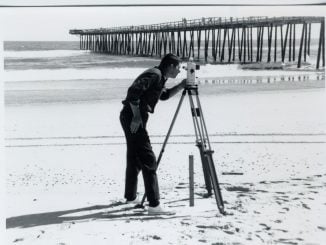LOS ANGELES — Stephen King’s “It” has always been a tough nut to crack. Though the mammoth novel has been reduced to a few indelible images and quotes over the decades — a killer clown, a balloon, “you’ll float too” — King’s story of seven youngsters who come of age while confronting a shape-shifting demonic presence in small-town Maine, then come home as adults to deal with its return, is quite a lot of things. It’s a messy, druggy attempt to distil decades of horror tropes into a chaotic fever dream; a portrait of a fictional town as obsessively mapped as Joyce’s Dublin; a meditation on childhood, trauma, and forgetting; “In Search of Lost Time” bloodied up for the grindhouse.
The second attempt to adapt King’s 1,100-page doorstop for the screen, director Andy Muschietti’s “It” is also a lot of different things. Focusing entirely on the childhood-set portions of King’s book, it’s a collection of alternately terrifying, hallucinatory, and ludicrous nightmare imagery; a sometimes jarring pileup of moods, ranging from haunted house horror to nostalgic hangout humor; a popcorn movie about gruesome child murders; a series of well-crafted yet decreasingly effective suspense setpieces; and a series of well-acted coming-of-age sequences that don’t quite fully mature. “It” looks poised to make a killing at the box office, but there’s a fundamental hollowness that haunts the film just as surely as the titular monster haunts this small town.

Perhaps that’s inevitable, as the film is incomplete by design, punting one half of its source material to a potential sequel — and considering the film’s pre-release tracking numbers, that sequel looks like a safe bet. Much like Quentin Tarantino’s first volume of “Kill Bill” offered a delirious yet morally unmoored mixtape of kung-fu spectacle, only for the second installment to provide the context that retroactively made it all meaningful, “It” very much feels like the flashier half of a longer story. As it stands, Muschietti (along with screenwriters Chase Palmer, Gary Dauberman and previously attached director Cary Fukunaga) has remained faithful to the book’s overall mood while diverging from its particulars, and King fans will surely appreciate the clear effort and affection that went into this adaptation, even as it struggles to become more than the sum of its parts.
Advancing the setting from the 1950s to the late 1980s, the film spans roughly nine months in the roughneck township of Derry, Maine, beginning with the brutal murder of six-year-old Georgie (Jackson Robert Scott). The novel’s famous opening sequence is largely adapted beat-for-beat, lingering with sickening unhurriedness on this sweet kid frolicking in the rain as he follows a paper boat into a storm drain, where he’s met by a sinister figure calling itself Pennywise the Dancing Clown (Bill Skarsgard), who sweet-talks him inch by inch toward his doom. It’s an upsettingly effective scene, and the rest of the film struggles to craft another with similar impact.
A few months later, Georgie’s older brother Bill (Jaeden Lieberher), wracked with guilt over sending Georgie out alone, is the last one still holding out futile hopes of finding him alive. Several other kids have since gone missing, and as school breaks for the summer, Bill enlists his clique of dorky buddies to help scout out the nearby streams for clues. His friends try their best to remain supportive, even as they’re more interested in talking about girls and avoiding the torments of the town’s psychotic bully, Henry Bowers (Nicholas Hamilton). The clan includes Richie (Finn Wolfhard), a crass, Coke-bottle-spectacled know-it-all; Eddie (Jack Dylan Grazer), an inhaler-wielding hypochondriac; and Stanley (Wyatt Oleff), a sclerotic skeptic heading unprepared into his bar mitzvah.
Their group, self-named “the Losers Club,” gradually grows to include Ben (Jeremy Ray Taylor), a shy new kid who spends his time in the library, and Mike (Chosen Jacobs), a home-schooled loner who also appears to be the only black kid in town. The biggest disruption, however, comes with the addition of Beverly (Sophia Lillis), a supremely confident, chain-smoking tomboy eager to escape her abusive home life. Both Bill and Ben are quick to fall in love with her, and the film is sensitive to the sometimes tender, sometimes unbearable awkwardness that ensues when puberty tosses a wrench into the already delicate machinery of male-female friendships.
Following the novel’s example, Muschietti has constructed a film that’s just as much “Stand by Me” as creature feature, and casting director Rich Delia goes above the call of duty assembling a group of youngsters who are every bit as funny, irritating and empathetic as the script requires. Lieberher and Lillis are particularly revelatory, their flirtations warm and believable, and Lillis bears more than just a superficial resemblance to a young Amy Adams. But Wolfhard all but steals the show as the gang’s cheerful antagonist Richie. Best known for his turn last year in “Stranger Things” — which itself shamelessly pilfered elements from “It” to more cohesive effect — the 14-year-old unleashes torrents of profanity and stupid-clever teenage quips with infectious panache.
Of course, there’s also the matter of the child-killing chthonian creature haunting their steps. One by one, It (a pronoun that gradually becomes a proper noun) appears to each of the Losers in a variety of guises, toying with them just long enough to scare them witless before reverting to its default form of Pennywise. Eventually, the kids all admit to one another that they’ve been having the same experiences, and bookish Ben connects the sinister goings-on to similar eruptions of violence throughout the history of Derry, a town where mysterious tragedy appears to strike every 27 years. Led by the increasingly committed Bill, the group resolves to fight back against It themselves, even if that means venturing into the town’s labyrinthine sewer system.
No matter how many awful fates befall “It’s” characters, the filmmaking itself is never sadistic. The action is generally clean and comprehensibly staged, with the long fun-house scene inside 29 Neibolt Street offering a particularly inventive set of scares, and composer Benjamin Wallfisch’s arsenal of spare piano pieces, breathy woodwinds and vortices of sampled children’s voices works wonders. Muschietti shares King’s love of period-appropriate rock music, though he doesn’t always use it appropriately: One potentially blood-curdling scene is bizarrely neutered by its use of the Cure’s “Six Different Ways.”

But as spine-tingling as a number of individual scenes are, the film struggles to find a proper rhythm. Scene-to-scene transitions are static and disjointed, settling into a cycle of .”..and then this happened” without deepening the overall dread or steadily uncovering pieces of a central mystery. Curiously, “It” grows less intense as it goes, handicapped by an inability to take in the scope of Derry as a town defined by its buried traumas and secrets, let alone really plumbing the primal depths of fear that It itself represents. As Pennywise, Skarsgard is largely tasked with providing a canvas for the film’s visual effects, and he never manages to cast as long a shadow as Tim Curry did with the character in the 1990 TV miniseries.
The film does, however, pick up on one key element of the novel, and King’s writing in general, that often goes missing in films based on his work: the notion that young people are uniquely burdened with atoning for the inequities of the adult world. Much of “It” takes place with no parents in sight, and when adults do break into the narrative, they’re invariably drunk, cruel, manipulative and indifferent if not hostile toward the fears and worries of those they ought to be protecting. As King puts it in the novel, “adults are the real monsters,” and Muschietti has plenty of ground left to cover when we see what kinds of adults these characters become.



